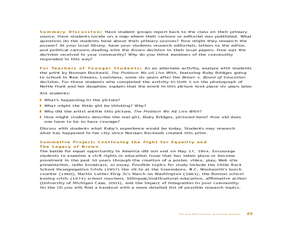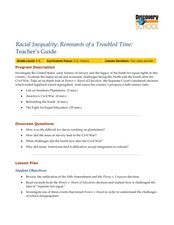Learning for Justice
The Color of Law: Creating Racially Segregated Communities
It is pointed, powerful, and painful! The first of three lessons about laws and practices that support inequality looks at how government policies created and reinforced segregated communities. Young social scientists read excerpts from...
Teaching Tolerance
Jim Crow as a Form of Racialized Social Control
Just because slavery was illegal doesn't mean it went away ... Jim Crow Laws took its place. An eye-opening lesson focuses on how Jim Crow Laws were used as a form of racial social control against African Americans in the United States....
Teaching Tolerance
Mass Incarceration as a Form of Racialized Social Control
Mass incarceration: A result of a tough stance on crime or racial discrimination, you decide. Academics explore the history and reasons behind mass incarcerations in the United States and its impact on ethnic communities. The...
Curated OER
In the 1960s, Why Were Boston’s Schools Racially Segregated?
Students explore the implications of segregation. In this Civil Rights lesson, students investigate what equal education is as they discover the state of Boston schools in 1960. Students define civil rights and discrimination as they...
K20 LEARN
The Bank Of Justice: Civil Rights In The US
To launch a study of racial segregation and integration, young historians first watch a news video about a prom in Georgia that was first integrated in 2013. They then compare the goals in Lincoln's Gettysburg Address to King's "I Have a...
Curated OER
Separate But Equal? A Lesson on the Briggs v. Elliott Case in Claredon County, SC
Third graders discussschool integration. In this racial inequality instructional activity, 3rd graders read Remember: The Journey to School Integrationand discuss the school facilities and how people must have felt. Students watch a...
EngageNY
Studying Conflicting Interpretations: Perspectives on Plessy v. Ferguson: Part 3
Scholars closely read Justice John Marshall Harlan's dissenting opinion in the Plessy v. Ferguson case, seeking to understand why he disagreed with the court's decision that racial segregation laws for public spaces were constitutional....
US House of Representatives
Keeping the Faith: African Americans Return to Congress, 1929–1970
The third instructional activity in a unit that traces the history of African Americans serving in the US Congress examines the period from 1929 through 1970. After reading a contextual essay that details the few African Americans...
Curated OER
Recognizing and Combating Segregation in U.S. Schools Today
Students explore the prevalence of racism and statistical segregation in America's schools. They design a project to investigate how the racial makeup of their school compares to other schools. In addition, they evaluate their design...
Curated OER
Bases Divided: Segregation And Discrimination in Baseball
Students view video and conduct research on how baseball has reflected the social context of American history. They work in groups to investigate outstanding minority baseball players, including racial minorities and women, and develop...
Curated OER
Fifty Years: From the Little Rock Nine to the Jena Six
Young scholars discuss how the issues surrounding school integration have changed since the Little Rock Nine entered Central High School. They discuss the recent events in Jena, Louisiana. Students write a letter to a school...
Curated OER
The Past Half Century: Achieving Equality
Students analyze reactions to the Brown vs. Education decision of 1954. In this segregation instructional activity, student look at the actions that were taken in the education world as a result of the Brown decision. They watch a CD,...
Curated OER
The Real Monopoly: America's Racial Wealth Divide
Students explore America's racial wealth divide. In this Teaching Tolerance instructional activity, students play a "rigger" version of the game Monopoly and reflect on the game and economic injustice in the United States.
Curated OER
Responses to Racially Imbalanced Schools
Students explore the implications of segregation. In this Civil Rights activity, students investigate what equal education is as they discover the state of Boston schools in 1960. Students define civil rights and discrimination as they...
C-SPAN
14th Amendment Equal Protection Clause
Two Supreme Court cases, Plessy v. Ferguson and Brown v. Board of Education take center stage in a lesson about the Equal Protection Clause of the 14th Amendment. Class members research both cases to compare and contrast the rulings.
Stanford University
Lesson Plan: The Children's Crusade and the Role of Youth in the African American Freedom Struggle
Young people played significant roles in the Civil Rights movement. Class members examine the contributions of Barbara Johns, Claudette Colvin, Mary Louise Smith, and the children of Birmingham,...
Anti-Defamation League
Sixty Years Later
Has any progress been made in desegregating schools since 1954's Supreme Court case Brown v. Board of Education? To find out, class members examine charts and graphs representing U.S. schools' racial, ethnic, and socioeconomic...
Curated OER
Racial Inequality: Remnants of a Troubled Time
Middle schoolers watch the Discovery program "Racial Inequality: Remnants of a Troubled Time" then examine the ratification of the 14th Amendment and the Plessy v. Ferguson decision. They research one of three events that tested Brown...
PBS
Ken Burns: Jackie Robinson Taking the Measure of a Man
During his first few games as the first black player in Major League Baseball, Jackie Robinson proved that he could withstand the wily curveball of Johnny Sain as well as the racial epithets shouted from opposing teams' dugouts. A short...
DocsTeach
Analyzing a Letter from Jackie Robinson: "Fair Play and Justice"
Jackie Robinson was more than a baseball legend; he was an activist, too. An interesting resource explores Robinson's time in the military using primary sources. Scholars examine the racially inspired event that led to a court martial...
Curated OER
"Jazz is About Collaboration": Jim Crow Laws And Segregation
Students explore development of jazz music in the 1930s by forming imaginary jazz bands which tour several cities in Depression-era America. Jazz band members create imaginary identities for themselves, develop publicity for their tour,...
Teaching Tolerance
Using Photographs to Teach Social Justice | Confronting Unjust Practices
A powerful photograph of the Freedom Riders of 1961 launches an examination of the de jure and de facto injustices that the civil rights movement of the 1950s and 1960s addressed. Young historians first watch a video and read the Supreme...
Curated OER
Only the Ball Was White
Tenth graders analyze how government policies on segregation effected the game of baseball. They evaluate how baseball and sports became a microcosm of the United States. They evaluate court decisions that lead to the segregation laws in...
Curated OER
Plessy V. Ferguson: "Separate but Equal," Equal Protection
Students explore the details and impact of the Plessy vs. Ferguson U.S. Supreme Court case. In this U.S. History lesson, students participate in several group discussions and group activities that examine both sides of the famous...

























